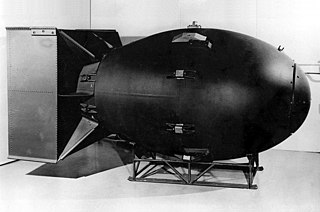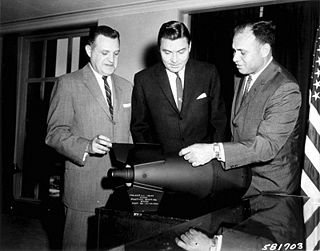
"Fat Man" is the codename for the type of nuclear bomb the United States detonated over the Japanese city of Nagasaki on 9 August 1945. It was the second of the only two nuclear weapons ever used in warfare, the first being Little Boy, and its detonation marked the third nuclear explosion in history. It was built by scientists and engineers at Los Alamos Laboratory using plutonium from the Hanford Site, and was dropped from the Boeing B-29 Superfortress Bockscar piloted by Major Charles Sweeney.

"Little Boy" was the type of atomic bomb dropped on the Japanese city of Hiroshima on 6 August 1945 during World War II, making it the first nuclear weapon used in warfare. The bomb was dropped by the Boeing B-29 Superfortress Enola Gay piloted by Colonel Paul W. Tibbets, Jr., commander of the 509th Composite Group of the United States Army Air Forces and Captain Robert A. Lewis. It exploded with an energy of approximately 15 kilotons of TNT (63 TJ) and caused widespread death and destruction throughout the city. The Hiroshima bombing was the second man-made nuclear explosion in history, after the Trinity nuclear test.

The M198 is a medium-sized, towed 155 mm artillery piece, developed for service with the United States Army and Marine Corps. It was commissioned to be a replacement for the World War II-era M114 155 mm howitzer. It was designed and prototyped at the Rock Island Arsenal in 1969 with firing tests beginning in 1970 and went into full production there in 1978. It entered service in 1979 and since then 1,600 units have been produced.

Los Alamos National Laboratory is one of the sixteen research and development laboratories of the United States Department of Energy (DOE), located a short distance northwest of Santa Fe, New Mexico, in the American southwest. Best known for its central role in helping develop the first atomic bomb, LANL is one of the world's largest and most advanced scientific institutions.

Nuclear weapon designs are physical, chemical, and engineering arrangements that cause the physics package of a nuclear weapon to detonate. There are three existing basic design types:

Nuclear artillery is a subset of limited-yield tactical nuclear weapons, in particular those weapons that are launched from the ground at battlefield targets. Nuclear artillery is commonly associated with shells delivered by a cannon, but in a technical sense short-range artillery rockets or tactical ballistic missiles are also included.

Operation Sandstone was a series of nuclear weapon tests in 1948. It was the third series of American tests, following Trinity in 1945 and Crossroads in 1946, and preceding Ranger. Like the Crossroads tests, the Sandstone tests were carried out at the Pacific Proving Grounds, although at Enewetak Atoll rather than Bikini Atoll. They differed from Crossroads in that they were conducted by the Atomic Energy Commission, with the armed forces having only a supporting role. The purpose of the Sandstone tests was also different: they were primarily tests of new bomb designs rather than of the effects of nuclear weapons. Three tests were carried out in April and May 1948 by Joint Task Force 7, with a work force of 10,366 personnel, of whom 9,890 were military.

The W54 was a tactical nuclear warhead developed by the United States in the late 1950s. The weapon is notable for being the smallest nuclear weapon in both weight and yield to have entered US service. It was a compact implosion device containing plutonium-239 as its fissile material, and in its various versions and mods it had a yield of 10 to 1,000 tons of TNT.

The W88 is an American thermonuclear warhead, with an estimated yield of 475 kilotonnes of TNT (1,990 TJ), and is small enough to fit on MIRVed missiles. The W88 was designed at the Los Alamos National Laboratory in the 1970s. In 1999, the director of Los Alamos who had presided over its design described it as "the most advanced U.S. nuclear warhead". As of 2021, the latest version is called the W88 ALT 370, the first unit of which came into production on 1 July, 2021, after 11 years of development. The Trident II submarine-launched ballistic missile (SLBM) can be armed with up to eight W88 warheads or twelve 100 kt W76 warheads, but it is limited to eight warheads under the Strategic Offensive Reductions Treaty.

Mark 7 "Thor" was the first tactical fission bomb adopted by US armed forces. It was also the first weapon to be delivered using the toss method with the help of the low-altitude bombing system (LABS). The weapon was tested in Operation Buster-Jangle. To facilitate external carry by fighter-bomber aircraft, Mark 7 was fitted with retractable stabilizer fins. The Mark 7 warhead (W7) also formed the basis of the 30.5 inches (775 mm) BOAR rocket, the Mark 90 Betty nuclear depth charge, MGR-1 Honest John rocket, and MGM-5 Corporal ballistic missile. It was also supplied for delivery by Royal Air Force Canberra aircraft assigned to NATO in Germany under the command of SACEUR. This was done under the auspices of Project E, an agreement between the United States and the UK on the RAF carriage of US nuclear weapons. In UK use it was designated 1,650 lb. H.E. M.C. The Mark 7 was in service from 1952 to 1967(8) with 1700–1800 having been built.

Gun-type fission weapons are fission-based nuclear weapons whose design assembles their fissile material into a supercritical mass by the use of the "gun" method: shooting one piece of sub-critical material into another. Although this is sometimes pictured as two sub-critical hemispheres driven together to make a supercritical sphere, typically a hollow projectile is shot onto a spike which fills the hole in its center. Its name is a reference to the fact that it is shooting the material through an artillery barrel as if it were a projectile.

The W50 was an American thermonuclear warhead deployed on the MGM-31 Pershing theater ballistic missile. Initially developed for the LIM-49 Nike Zeus anti-ballistic missile, this application was cancelled before deployment. The W50 was developed by Los Alamos National Laboratory. The W50 was manufactured from 1963 through 1965, with a total of 280 being produced. They were retired from service starting in 1973 with the last units retired in 1991.

The W48 was an American nuclear artillery shell, capable of being fired from any standard 155-millimetre (6.1 in) howitzer. A tactical nuclear weapon, it was manufactured starting in 1963, and all units were retired in 1992. It was known as the XM454 AFAP in US service.

The W79 Artillery-Fired Atomic Projectile (AFAP), also known as the XM753 (Atomic RA) was an American nuclear artillery shell, capable of being fired from any NATO 8 in (203 mm) howitzer e.g. the M115 and M110 howitzer. Produced in two models, the enhanced radiation W79 Mod 0 and fission-only W79 Mod 1. Both were plutonium-based linear-implosion nuclear weapons.

The W86 was an American earth-penetrating nuclear warhead, intended for use on the Pershing II intermediate-range ballistic missile (IRBM). The W86 design was canceled in September 1980 when the Pershing II missile mission shifted from destroying hardened targets to targeting soft targets at greater range. The W85 warhead, which had been developed in parallel with the W86, was used for all production Pershing II missiles.

The W73 was a planned nuclear warhead for the AGM-53 Condor air to surface missile and designed by Los Alamos Scientific Laboratory. The W73 warhead was cancelled in 1970 in favor of a purely conventional warhead for Condor. Condor was approved for production in 1975 with a expected production run of 250 missiles, but was cancelled in early 1976 due to high cost.

The W33 was an American nuclear artillery shell designed for use in the 8-inch (203 mm) M110 howitzer and M115 howitzer.

The W82 was a low-yield tactical nuclear warhead developed by the United States and designed to be used in a 155 mm artillery shell. It was conceived as a more flexible replacement for the W48, the previous generation of 155 mm nuclear artillery shell. A previous attempt to replace the W48 with the W74 munition was canceled due to cost.
The W60 was nuclear warhead developed for the United States Navy's long range Typhon LR surface-to-air missile.
The W64 nuclear warhead was the Los Alamos Laboratory's entry into a brief competition between Lawrence Livermore Laboratory and Los Alamos to design an "enhanced-radiation" nuclear warhead for the United States Army's MGM-52 Lance tactical surface-to-surface missile. In July 1964, both Livermore Labs and Los Alamos started developing competing warheads for the Lance. The Los Alamos design, the W64, was canceled in September 1964 in favor of Livermore's W63. In November 1966, the W63 was canceled in favor of the W70, the model that finally entered production.


















